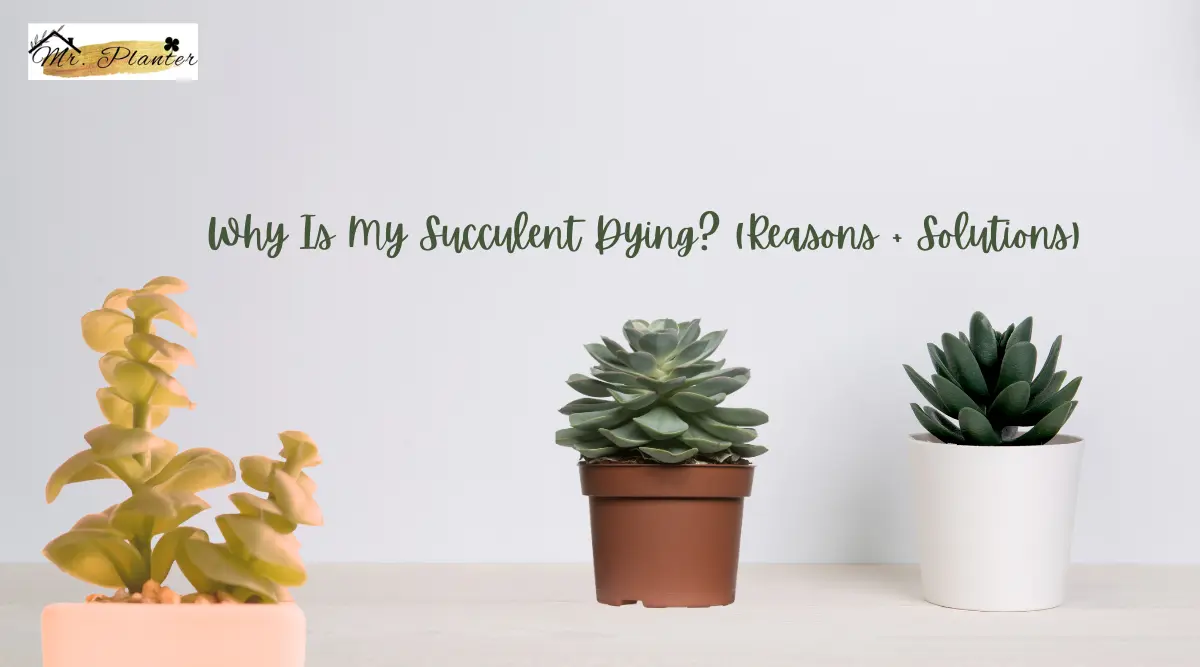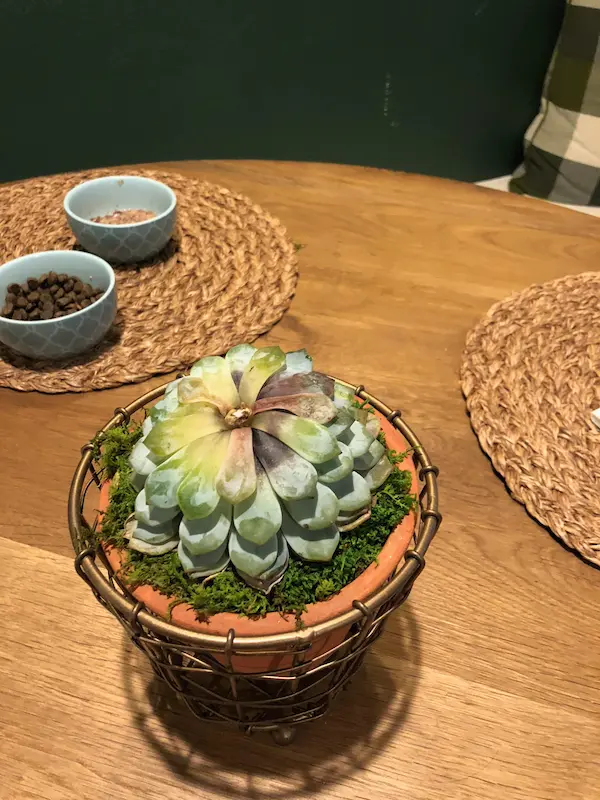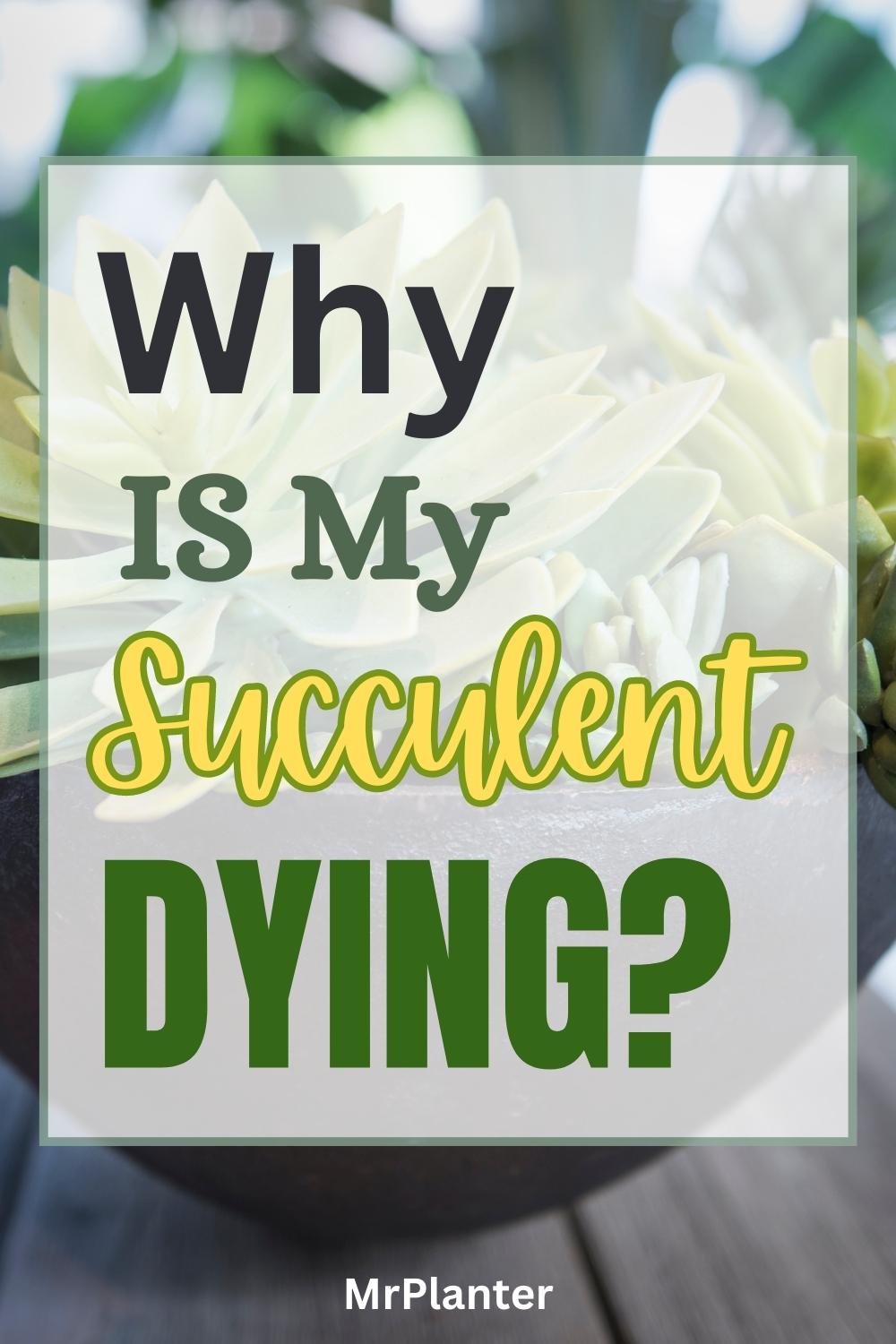Succulents are beloved for their unique beauty and resilience, but even these hardy plants can face challenges that lead to their demise.
If you’ve noticed your succulent showing signs of distress, promptly identifying the underlying causes is essential.
In this article, we’ll explore common reasons why is my succulent dying and provide helpful solutions to revive them.

By understanding these issues and implementing suitable remedies, you can ensure the health and longevity of your succulent collection.
Reasons Why Your Succulent is Dying
Succulents are known for their resilience but can face challenges that lead to their decline.
Understanding the reasons behind your succulent’s struggle is vital for providing the necessary care.

Let’s explore the common factors that can cause your succulent to wither and the solutions to revive it.
Overwatering
Overwatering is one of the most common reasons for succulent decline.
These desert plants store water in their leaves, stems, or roots, making them highly susceptible to root rot and other fungal diseases if exposed to excess moisture.
Signs of overwatering include mushy or blackened roots, wilting leaves, and leaf drops.
Allow the soil to dry out completely between waterings. Check the moisture level by sticking your finger about an inch into the soil – if it feels dry, it’s time to water.
Use a well-draining soil mix, and ensure the pot has drainage holes to prevent water from pooling around the roots.
High Temperature
Succulents thrive in warm climates, but excessively high temperatures can lead to stress and even death.
When temperatures exceed the succulent’s ideal range, they may suffer from heat stress, resulting in wilting, discoloration, or even scorched leaves. Prolonged exposure to intense sunlight during peak hours can amplify this issue.
Provide shade during the hottest parts of the day by moving the succulent to a more shaded area or using shade cloths.
Additionally, consider relocating indoor succulents away from direct sunlight through window coverings or placing them in a cooler room.
Low Temperature/Frost
A succulent is very much susceptible to frost and rotting.
So, if your area is in a very cold place with snowfall and temperature dropping, you can keep the succulent inside in your room.
Underwatering
Underwatering can lead to succulent deterioration on the opposite end of the spectrum.
When deprived of water for extended periods, succulents may lose their plumpness, with leaves becoming wrinkled, shriveled, and discolored.
Water your succulents thoroughly and consistently, ensuring the entire root system receives adequate hydration.
When watering, pour water directly onto the soil rather than the leaves, as wet leaves can be more susceptible to rot and sunburn.
Harsh Lighting
While succulents typically enjoy bright light, intense and direct sunlight can be detrimental to some varieties.
Prolonged exposure to harsh light, especially during the hottest part of the day, can cause sunburn and damage the plant’s cells.
Gradually acclimate your succulent to brighter light conditions by moving it to a sunnier spot over several days.
Provide shade or use a sheer curtain to filter the sunlight if outdoor temperatures are scorching.
Indoor succulents should be placed near a bright window but not in direct sunlight all day.
No Sunlight
On the flip side, insufficient light can be equally harmful to succulents.
Lack of sunlight can lead to etiolation, a condition in which the plant stretches out and becomes leggy as it searches for more light.
Place your succulent in a well-lit area, preferably where it can receive at least 6-8 hours of indirect sunlight daily. Rotate the plant occasionally to promote even growth.
How to Save Your Succulent from Dying?
Once you’ve identified the reasons behind your succulent’s decline, it’s time to take action and rescue your plant.
Sick Succulent 🙁
Here are some practical solutions to nurse your succulent back to health.
Fix Succulent Pot Drainage
Ensure that your succulent pot has adequate drainage holes.
If not, consider repotting it into a container with drainage holes to prevent water from accumulating and causing root rot.
Also, if possible, you can create drainage holes below the succulent pot to help drain the excess water to prevent succulent from being overwatered and also would prevent root rot.
Change the Soil
If you suspect root rot or poor drainage is the issue, report your succulent into fresh, well-draining soil.
Remove any mushy or rotten roots and allow the plant to dry for a day before repotting.
Make the Root Dry
If you have overwatered your succulent, remove it from the pot and gently shake off excess soil.
Let the plant sit out of the soil for a day or two to allow the roots to dry before replanting.
Follow the Watering Schedule the Right Way
Establish a consistent watering schedule based on your succulent’s needs.
Stick to a routine but adjust it according to environmental factors like season, temperature, and humidity.
Report With the Right Type Of Soil
Use a well-draining soil mix specifically formulated for succulents and cacti.
This type of soil allows excess water to drain away quickly, preventing waterlogged conditions.
Bring In the Succulent from Outside
In case your area is extreme cold or hot, its must to take your succulent back inside your home.
Once you bring your succulent inside your home, you can keep it near windowsill so that it receives indirect sunlight during the day.
This will help in recovering your succulent fast and effectively.
Can You Revive A Dying Succulent?
Reviving a dying succulent is possible in many cases, but success depends on the extent of damage and how quickly you take action.
The key to restoring a dying succulent lies in identifying the problem early and providing the appropriate care and treatment. Here’s a step-by-step guide on how to restore a dying succulent:
Assessment:
First, carefully inspect the plant to determine the extent of damage and identify the underlying issue.
Look for signs of overwatering, underwatering, root rot, pests, or diseases. Identifying the problem will guide you in providing the right solution.
Isolate the Plant:
If you suspect a pest infestation or infection, isolate the dying succulent from other healthy plants to prevent further spread.
Adjust Watering:
Overwatering is a common cause of succulent decline. If the plant shows mushy or blackened roots, stop watering immediately.
Allow the soil to dry out completely before attempting to water again.
Make the Root Dry:
Carefully remove the succulent from its pot and gently shake off excess soil. Inspect the roots and trim away any rotten or damaged roots.
Let the plant sit out of the soil for a day or two to allow the roots to dry before replanting.
Repotting:
If the succulent’s current soil is waterlogged or lacks drainage, repot the plant into fresh, well-draining soil.
Use a soil mix specifically formulated for succulents and cacti, allowing excess water to drain quickly.
Provide Adequate Light:
Ensure the succulent receives sufficient light without exposure to harsh, direct sunlight.
Gradually acclimate the plant to brighter light conditions if kept in low light.
Adjust Temperature:
Protect the succulent from extreme temperatures, especially during the hottest part of the day.
High temperatures can stress the plant, leading to wilting or scorching.
Remove Pests:
If you notice any pests on the plant, such as mealybugs, aphids, or spider mites, remove them manually or use an appropriate natural insecticide.
Ensure that the plant is pest-free before bringing it back near other plants.
Patience and Observation:
Reviving a dying succulent takes time, and you must be patient. Monitor the plant closely and adjust your care routine based on its response.
Avoid making sudden changes, as succulents prefer gradual adjustments.
Pruning:
If the succulent has extensive damage or leggy growth due to a lack of light, consider pruning it.
Trim off leggy stems to encourage new growth and improve the plant’s appearance.

Frequently Asked Questions
Why is My Succulent Dying?
Common reasons for succulent decline include overwatering, high or low temperature, underwatering, harsh lighting, and lack of sunlight. Proper care, including well-draining soil, appropriate watering, and appropriate lighting, can help revive a struggling succulent.
How do you revive a dying succulent?
To revive a dying succulent, you should assess the plant’s current condition, adjust its watering and sunlight exposure, prune away dead or damaged parts, and consider repotting it in fresh soil.
What do succulents look like when overwatered?
When overwatered, succulents may appear swollen, mushy, and discolored. The leaves may also become translucent and fall off easily. Additionally, the roots may rot, and the plant may have a foul odor.
Key Takeaways:
So, finally here are the key takeaways:
- Identifying Causes for Decline: Even tough succulents can face challenges leading to their decline. It’s crucial to recognize the underlying issues causing distress in your succulent plants.
- Common Culprits and Solutions: The post outlines common reasons for succulent struggles, such as overwatering, high/low temperatures, inadequate lighting, and more. Each issue is accompanied by practical solutions to revive the plants.
- Proactive Care: Proper care involves adjusting watering schedules, repotting in well-draining soil, providing suitable light conditions, and protecting from extreme temperatures. Patient observation and gradual adjustments are key to successful recovery.
- Assessment and Pruning: Reviving a dying succulent involves careful assessment, isolation from healthy plants if needed, root examination, repotting, and potentially pruning for new growth. Patience, monitoring, and proper care are essential for a successful revival.

